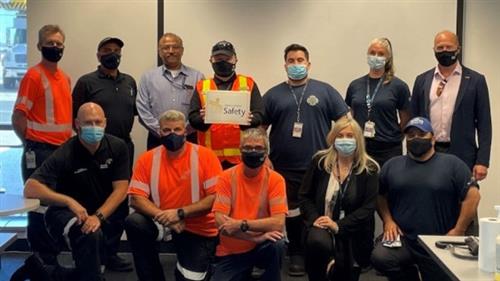Save 10% off at Mark’s all year round
Wearing the appropriate Personal Protective Equipment (PPE) is the best way to help protect you from hazards that may harm you and that you’re protecting yourself. We want to help make sure you’re safe every day. We’ve worked with Mark’s to offer all airport employees a 10% off coupon for regularly priced merchandise to ensure you have the right PPE to work safely.
10% off all regularly priced products at any of Mark’s 380+ retail stores across Canada. Year-round, expires June 2024. The offers cannot be used on items already discounted.
Get involved
We offer many opportunities to get involved in safety programs or events, such as:
- Crew room visits
- Safety Forums for leaders and airport workers
- Shift briefings and job aids
- Courses
- Annual events
- Safety recognition program
- Suspicious Sam Program
If you have a question, would like to attend our Safety forums, or want to get involved, contact the Toronto Pearson Safety Program team.
Eye on Safety Award Nominee Spotlight
High winds event: Recently, a unit load device (ULD)—a container used to load luggage, freight, and mail onto aircraft—blew over on the airfield and almost struck an aircraft. Syed, a Ramp Service Agent with WestJet, was quick to react, using a tractor to prevent the unit from causing an aircraft collision. Thanks, Syed!

Michelle, an Air Canada employee and Health & Safety Representative with CUPE Local 4092, has been exemplary in her commitment to safety with our workforce this year. Six months ago, our group lost its Health & Safety team through attrition, and Michelle came forward to fill the role she has with the union today. Michelle has courageously stepped up to the plate in her commitment to ensuring workers have access to Health and Safety resources.
Michelle successfully completed the training despite a steep learning curve and has been a stellar example of going above and beyond for the betterment of our workgroup. She's already taken on a strong voice of leadership and mentorship through promoting and demonstrating safety awareness and proactive reporting of concerns in the workplace. Thanks, Michelle!
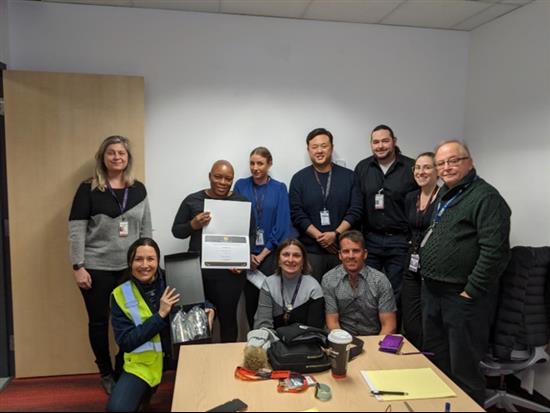
Claire was alone in an area in Terminal 1 when she smelled natural gas after a restaurant had closed and employees had left, but to her credit, Claire was on the ball, calling operations to request GTAA Fire and Emergency Services. A gas leak was confirmed at an appliance; had Claire ignored her instinct, this could have resulted in a fire in the restaurant. Thanks, Claire!
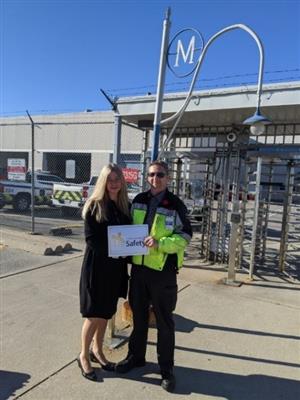
SkyService employee Jonathan described being on the SkyService apron preparing to tow an aircraft when he looked back at the runway as an aircraft was taking off. That’s when he noticed it appearing that something had fallen off the aircraft. Jonathan wisely radioed the SkyService office and requested that they call GTAA operations and advise them of the sighting. A subsequent runway inspection found two aircraft chocks—safety devices that prevent an aircraft from moving while parked—on the runway. Thank you, Jonathan!

Matthew, Station Attendant Lead with Air Canada, was relayed incorrect push-back instructions from the fight crew he was working with recently while out on the airfield. Prior to starting the instructions, Matthew asked for clarity and proactively made recommendations for a safe push-back, which was done. He later reported the incident through the appropriate channels to be looked into, and the Safety Management Systems team would like to recognize him for his actions. Thanks, Matthew!
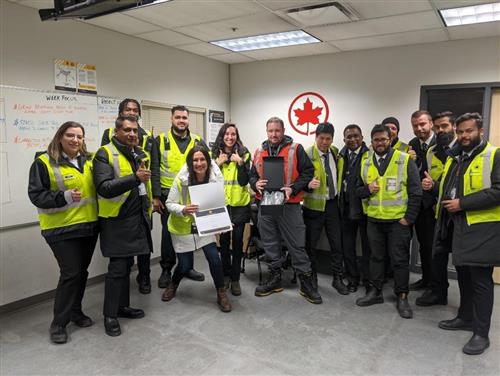
Do you know someone who should be nominated for an Eye on Safety Award? Nominate them now.
Keeping apron clear
Let’s work together to keep the apron clear to give snow clearing equipment the opportunity to clean spaces quickly and efficiently.
Before the pushback of an aircraft from the gate, please ensure that:
- The ground power unit (GPU) cables are retracted, secured by the lanyard, and that the weather cap is installed
- The pre-conditioned air (PCA) hoses are securely stowed in the bin
- The visual docking guidance system (VDGS) cord is retracted and stowed properly
- The potable water cabinet (PWC) hose is retracted and the doors are secured in the closed position;
- Ensure the A/C is not overfilled with water as it results in ice on the gate, and
- Any leaks in the hose/water cabinet should be called into Airport Operations as it can result in ice
- All chocks, pylons and portable service stairs are safely stored in their designed locations
- the passenger boarding bridge (PBB) is returned to the designated parking circle upon retraction from the aircraft
- All ground support equipment (GSE) is returned to their designated parking locations unless directed otherwise by snow removal crews in preparation for gate snow clearing operations
These photos show gates that are not able to be properly cleared of snow because items have been left on the apron.
Aviation Hazards Control & Mitigation
Every year, the Aviation Safety Management team completes a full review of hazard performances. This is a full review of the hazards that we have identified that require control and or mitigation to ensure we are operating in a safe environment.
For 2023, the safety risk profile includes themes within the maneuvering area and apron area, which include: Runway Incursions, Airfield Electrical, Surface Openings/Closures, Collision-Vehicle/Equipment/Bridge/Building, Aircraft cut-off - Aircraft/Vehicle, and Aircraft Parking.
Definitions:
- Runway Incursions = Unauthorized presence of an aircraft, vehicle, or pedestrian on a runway
- Airfield Electrical = Non-compliance/technical failure in airfield lighting and signage
- Surface Openings/Closures = Gaps within the process of opening/closing a surface on the maneuvering area
- Collision-Vehicle/Equipment/Bridge/Building = Contact between vehicle/equipment/bridge and buildings
- Aircraft cut-off - Aircraft/Vehicle = Failing to yield right of way to an aircraft or aircraft tow crew
- Aircraft Parking - A/C parked unsafely/improperly and A/C parked at wrong gate
Our goal is to decrease the number of trended incidents within these categories by 5%. To do so, we will be working with our hazard owners, both external and internal to the GTAA, to identify objectives that will help drive change in these areas.
People movers and emergency stops
Did you know that escalators and moving walkways have emergency stop buttons? They can be found at the entrance, exit, and along the length of the unit. The emergency stop buttons can be pressed to stop the moving device to ensure the safety of passengers and employees. As an airport employee, if you see passengers struggling with baggage, strollers, personal mobility device etc. kindly redirect them to the closest elevators. Some examples of when the emergency stop button should be used include:
- When a fall occurs
- If clothing or shoelaces become caught in the unit<
- If there is an unsafe item brought onto the unit
- Loaded baggage cart
- Heavy items
Any passengers carrying excess baggage, strollers, or who use personal mobility devices should use an elevator, as these items can lead to trips and falls when brought onto escalators and moving walkways.
As a reminder, all trips and falls should be called into airport operations at 416-776-3055 or emergency operations at 416-776-3033 should it be a medical emergency.
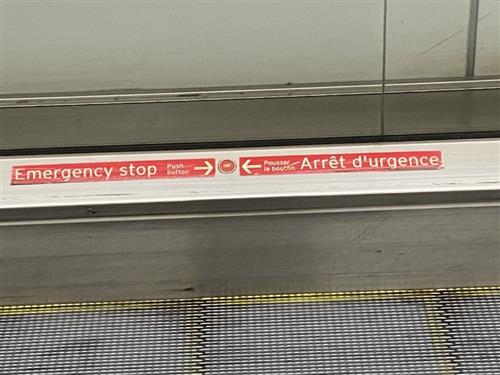
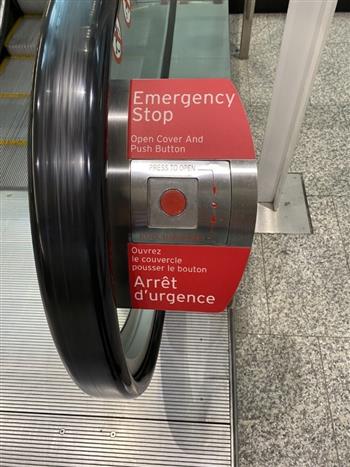
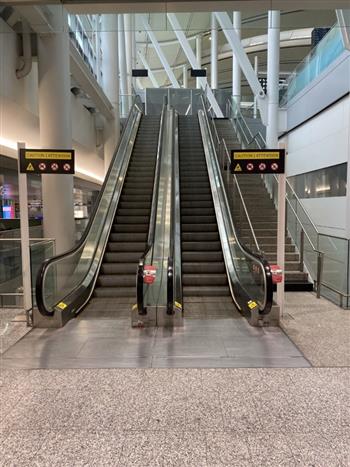
Reminder: Need and right required for Transborder Sector access
Access into and through the U.S. Transborder/Preclearance Departure Area is strictly prohibited to personnel who are authorized to access and or scheduled to work (need and right) within the area.
Only those personnel with a need and right to be in the Preclearance areas while performing their work-related duties, as assigned by their employer, are permitted to enter at any time.
Employees Restricted Area Identification Cards (RAICs) must also be visible at all times in all secure areas. Failure to abide by these access restrictions will result in the suspension of airport access privileges of the offending person.
You are prohibited from:
- Accessing these areas if not working in the area;
- Loitering in these areas;
- Using these areas as a shortcut, and;
- Using concessions or other facilities in this area unless you are working directly in the U.S. Transborder areas.
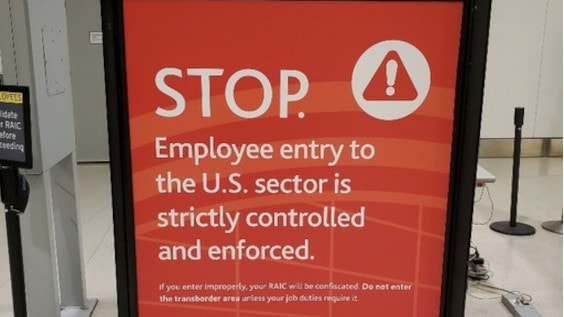
Vehicle Safety-Helpful tips to protect yourself
Helpful steps you can take that may protect yourself:
When parking your vehicle:
- Park in a well-lit, attended area if possible
- Lock all valuables in your trunk
- Completely close and lock doors and windows
- Turn your wheels to the side to make it harder to tow
When at home:
- If you have a garage, use it and lock it
- If you have a rear-wheel drive car, back into driveway
- If you have a front-wheel drive car, park front end first
- If you have a second vehicle, park it directly behind a newer or high-end vehicle
- Don’t leave your key FOB by your front door, store them far away from your vehicle. Alternatively, store your keys in a FARADAY/RFID blocking device when possible.
- Ensure your property is well lit.
Invest in vehicle protection whenever possible:
- Steering wheel lock - Prevents the steering wheel from turning
- Electronic alarms - Alarms with kill switches are the most effective
- Vehicle tracking systems - A transmitter in your vehicle enables your vehicle to be tracked electronically
If you have any information regarding criminal activity, contact Peel Crime Stoppers at 1800-222-TIPS.
Report any suspicious activity or individuals in the terminals or parking facility to Security Operations at 416-776-7381.
Source: Toronto Police Service Website https://www.torontopolice.on.ca/crimeprevention/autotheft.php
Safety Spotlight: Keeping safety simple with Paul Woods, Manager, Aviation Regulatory Programs

Paul has worked at the GTAA since 2002 in a variety of roles, including Safety and Security, Emergency Management, AVOP, Wildlife Management, and Training Standards. When it comes to safety, Paul believes in keeping it simple; in an article he wrote for LinkedIn at the height of the pandemic, he poses the question: Are we making it easy for people to be safe?
Currently, Paul is Manager of Aviation Regulatory Programs, where he and his team collaborate with a wide group of colleagues on airfield infrastructure projects as well as maintain the publications and standards supporting Pearson’s operating certificate. Read Paul’s article on keeping safety simple: https://www.linkedin.com/pulse/we-keeping-safety-simple-paul-woods
People and planes appreciation breakfast
The Governance Corporate Safety & Security and Airport Operations teams began the Reimagination Project in 2022. Working together, the teams have designed the new model for safety under a “Safety Centre of Excellence” focused on people (workplace, health and passenger safety) and planes (aviation safety) that aligns with Canadian and International Standards (ISO 45001) and the Canadian Aviation Regulations. An Appreciation breakfast sponsored by Kath Hammond, Vice President, General Counsel, Corporate Safety, Security and Craig Bradbrook, Chief Operating Officer, was held to celebrate all of the safety champions involved in this project continuing to advance safety at Toronto Pearson.
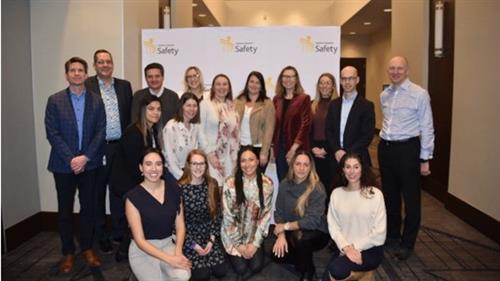
Recognizing the efforts of the Central De-icing Facility (CDF) team
Injuries to the bones, muscles, tendons, ligaments, and soft tissues are the biggest cause of lost time injuries among workers. They’re most often caused by manual handling injuries like lifting, carrying, or repetitive movements, and these painful injuries can often take months to treat.
Since 2018, the GTAA has partnered with industry-leading manual and movement experts with training provider Pristine Condition to advise and guide us on how to move safely at work and home.
Congratulations to our CDF team for the exceptional results in Training Risk Assessment Corrective Action (TRACA) observations, a fun and engaging way to practice proper techniques to prevent injury and build healthy habits!
